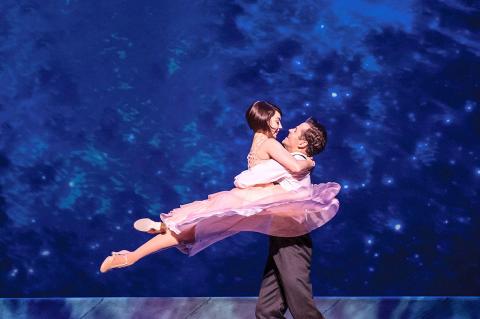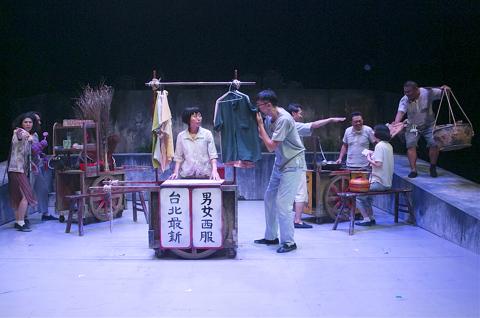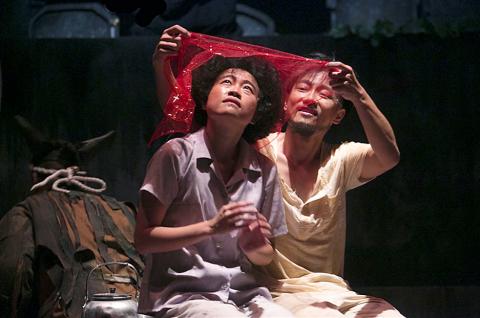Three years ago, the National Taichung Theater launched its summer musical program, which would feature two musicals each summer, one Taiwanese, the other an imported production.
In 2017, the import was the Japanese hit Death Note The Musical (死亡筆記本), based on the Death Note manga series by Tsugumi Ohba.
Last year it was the South Korean musical Fanletter, about Korean writers under Japanese colonial rule in the 1930s

Photo courtesy of National Taichung Theater
This year it is British ballet choreographer Christopher Wheeldon’s retelling of the story of the 1951 Academy Award-winning film An American in Paris.
The frothy film, which starred Gene Kelly and Leslie Caron, was nominated for eight Oscars and took home six. Wheeldon’s production, An American in Paris: The Musical has been as equally acclaimed, being nominated for 12 Tony awards and winning four — for choreography, set and lighting designs for a musical, and orchestration — as well as 12 more awards from theater and critics’ groups in New York City.
Wheeldon, a Royal Ballet principal dancer turned choreographer, had never directed a musical or a theater production before he tried his hand with An American in Paris, but he was not without experience in mounting large-scale works.

Photo courtesy of National Taichung Theater
He had created short works for ballet companies around the world as well as the full-length Alice’s Adventures in Wonderland for the Royal in 2011. He also choreographed for the closing ceremony of the London Olympics in 2012.
For An American in Paris: The Musical, he kept the music created by the Gershwin brothers, George and Ira — Ira wrote the lyrics — and brought Bob Crowley to create the sets and costumes. He also tinkered with the movie’s storyline, which was always a bit thin.
Set in the newly liberated Paris of 1945, the film told the story of three young men, former US Army soldier Jerry Mulligan, who has decided to stay in Paris after the end of World War II to try to become an artist; Adam Cook, a concert pianist who dreams of being a composer and Henri Baurel, a nightclub singer.

Photo courtesy of National Taichung Theater
A wealthy American woman and art collector, Milo Roberts, is in love with Jerry, but he falls in love with a ballet dancer, Lise Bouvier, who Henri has been in love with for years. The question is who Lise will end up with.
In Wheeldon’s musical, Jerry does fall in love with Lise, but now he must compete with both Henri and Adam for her hand, while Milo’s role has been enhanced as she is financing a new ballet in which Lise is to star.
The musical opened in Paris on Dec. 10, 2014 for a four-week run, and underwent several revisions before it premiered on Broadway on April 12, 2015. It was one of the hottest-selling shows before it closed in October the following year, when a US touring production began, while a West End production in London opened in March 2017, which was also a critical and commercial hit.

Photo courtesy of Johan Persson
In Taichung, the show will be performed in English, with Chinese surtitles, and will run about two-and-a-half hours with one intermission.
Ryan Steele and Leanne Cope will play Jerry and Lise in the evening shows on Aug. 20 to 23 and the two weekend matinees, while Nathan Madden and Kristen McGarrity take over the roles for the evening shows on Aug. 24 and 25.
However, before post-war Paris and brash Americans take over the National Taichung Theater, a much darker home-grown musical production, An Oxcart for Dowry (嫁妝一牛車), will be at the Playhouse this weekend.
A collaboration between Chiayi-based Our Theatre (阮劇團) and Japanese director Sho Ryuzanji’s Ryuzanji Jimusho group, the production is an adaptation of Taiwanese author Wang Chen-ho’s (王禎和) acclaimed 1967 short story of the same name.
Our Theatre and Ryuzanji have collaborated several times before, including Macbeth in 2016 and Macbeth: Paint It, Black! the following year.
The 16-year-old troupe focuses on folk culture and common people and is devoted to developing productions from a southern point of view and performed in Hoklo (also known as Taiwanese), so its aesthetics match those of Ryuzanji, a theater and film actor/director who believes that theater should be for everyone and by everyone, especially those often excluded by mainstream society.
An Oxcart for Dowry is a black comedy that tells the story of a poor man, a deaf carter who dreams of owning his own oxcart, his gambling addicted wife and a small-time clothes merchant who has been having an affair with his wife.
The carter is openly mocked by his fellow villagers over his wife’s cuckolding him, but he can neither hear their jeers or the couplings of his unfaithful wife.
All three are struggling to survive on the fringes of a rapidly modernizing Taiwan, but it is the carter who bears the brunt of the burden. Caring for an ill son eats up all his money, and when he is blamed for an accident that injures a child, he ends up in prison. When he is released, he ends up sharing a hovel with his wife and her lover.
The show will be performed in Taiwanese with Chinese surtitles for the lyrics. It runs about 110 minutes, without an intermission.
Performance Notes
WHAT: An American in Paris: The Musical
WHERE: The Grand Theater at the National Taichung Theater (臺中國家歌劇院大劇院), 101 Huilai Rd, Sec. 2, Situn District, Taichung (臺中市西屯區惠來路二段101號)
WHEN: Aug. 20 to 25 at 7:30pm, Aug. 24 and 25 matinees at 2:30pm
ADMISSION: Aug. 20 to 22, the only remaining seats are in the NT$2,000 and NT$3,200 range; Aug. 23 to Aug. 25, remaining seats are NT$2,800 to NT$4,400; available at available at NTCH and NTT box offices, Eslite ticket desks, online at www.artsticket.com.tw and at convenience store kiosks
WHAT: An Oxcart for Dowry
WHERE: The Playhouse at the National Taichung Theater (臺中國家歌劇院大劇院), 101 Huilai Rd, Sec. 2, Situn District, Taichung (臺中市西屯區惠來路二段101號)
WHEN: Saturday and Sunday 2:30pm
ADMISSION: NT$400 to NT$800; available at available at NTCH and NTT box offices, Eslite ticket desks, online at www.artsticket.com.tw and at convenience store kiosks

June 23 to June 29 After capturing the walled city of Hsinchu on June 22, 1895, the Japanese hoped to quickly push south and seize control of Taiwan’s entire west coast — but their advance was stalled for more than a month. Not only did local Hakka fighters continue to cause them headaches, resistance forces even attempted to retake the city three times. “We had planned to occupy Anping (Tainan) and Takao (Kaohsiung) as soon as possible, but ever since we took Hsinchu, nearby bandits proclaiming to be ‘righteous people’ (義民) have been destroying train tracks and electrical cables, and gathering in villages

Dr. Y. Tony Yang, Associate Dean of Health Policy and Population Science at George Washington University, argued last week in a piece for the Taipei Times about former president Ma Ying-jeou (馬英九) leading a student delegation to the People’s Republic of China (PRC) that, “The real question is not whether Ma’s visit helps or hurts Taiwan — it is why Taiwan lacks a sophisticated, multi-track approach to one of the most complex geopolitical relationships in the world” (“Ma’s Visit, DPP’s Blind Spot,” June 18, page 8). Yang contends that the Democratic Progressive Party (DPP) has a blind spot: “By treating any

This year will go down in the history books. Taiwan faces enormous turmoil and uncertainty in the coming months. Which political parties are in a good position to handle big changes? All of the main parties are beset with challenges. Taking stock, this column examined the Taiwan People’s Party (TPP) (“Huang Kuo-chang’s choking the life out of the TPP,” May 28, page 12), the Democratic Progressive Party (DPP) (“Challenges amid choppy waters for the DPP,” June 14, page 12) and the Chinese Nationalist Party (KMT) (“KMT struggles to seize opportunities as ‘interesting times’ loom,” June 20, page 11). Times like these can

Swooping low over the banks of a Nile River tributary, an aid flight run by retired American military officers released a stream of food-stuffed sacks over a town emptied by fighting in South Sudan, a country wracked by conflict. Last week’s air drop was the latest in a controversial development — private contracting firms led by former US intelligence officers and military veterans delivering aid to some of the world’s deadliest conflict zones, in operations organized with governments that are combatants in the conflicts. The moves are roiling the global aid community, which warns of a more militarized, politicized and profit-seeking trend